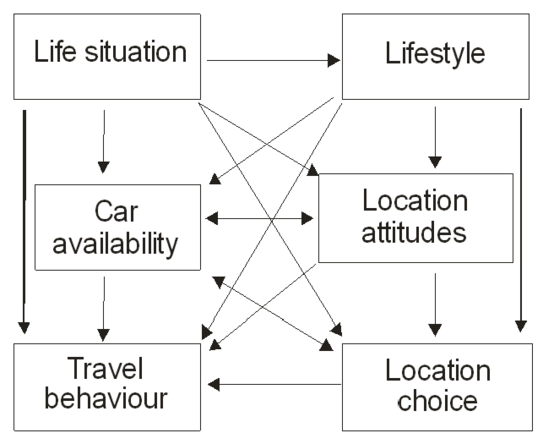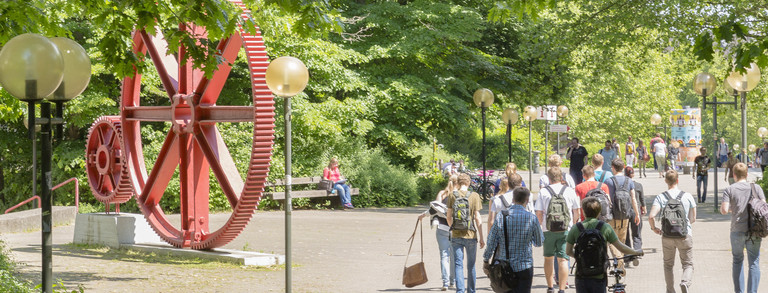Choice of residential location, the built environment and transport in the context of lifestyle and life situation (2006-2008)
The project was a follow up project to StadtLeben that was completed in March 2005. It was funded by the German Research Foundation (DFG), while StadtLeben was funded by the German Federal Ministry of Education and Research.
Objectives
The project is devoted to the empirical analysis of the complex interrelations between life situations, lifestyles, location attitudes, residential location choice, and travel behaviour. It is based on theoretical models which integrate our own and others' empirical work. Methodologically the project is based on data that has been collected during the project StadtLeben in a questionnaire survey in ten study areas within the region of Cologne. The data are complemented by disaggregate spatial information on facilities in the areas which were merged with the household data.
The results of the project shall provide further insight
- into the role that lifestyles and life situations (i.e. social, material and other resources and conditions, as reflected by socio-demographics) play for residential location choice and travel behaviour
- into the influence of the 'objective' built environment as opposed to subjective attitudes towards location, travelling and accessibility on travel behaviour ('residential self-selection hypothesis')
- into the intermediate role of car availability between life situation and lifestyle on the one hand, and travel behaviour on the other hand.
What is more, conclusions shall be drawn for the improvement of transport modelling.
Methodology
The analyses are based on multivariate statistical methods, specifically on linear structural equation modelling, supplemented by regression analysis. Structural equation modelling allows for the examination of complex interrelations between variables, including intermediate variables which are simultaneously exogeneous to some variables and endogeneous to others.
In other words, intermediate variables are determinants to some things (they shall 'explain something') while being dependent on other things at the same time. For instance, lifestyles shall contribute to explaining the differences in travel behaviour between various population groups, while lifestyles are also depending on the life situations of the respective lifestyle groups. The figure shows an example for a model structure which is used in the project.

Results
The results prove the complex interrelations between social structures, housing, and travel behaviour. They indicate the relevance of residential self-selection, i.e. travel and accessibility preferences for the choice of residential location and for travel behaviour. Concerning the impact of lifestyles v. life situations, the findings strongly support the importance of life situations (more specifically, social status) for travel behaviour, while the impact of lifestyles is limited. However, lifestyles play a major role for leisure travel.
The project was executed at the transport research group, Department of Spatial Planning.
Funding: German Research Foundation / Deutsche Forschungsgemeinschaft (DFG)
Funding code: HO 3262/2-1
Project start and end: März 2006 bis Februar 2008
Contact
Prof. Dr. Joachim Scheiner, joachim.scheinertu-dortmundde, Tel.: ++49 (0)231 755-4822
Related publications
Scheiner, Joachim / Holz-Rau, Christian (2013): Changes in travel mode choice after residential relocation: a contribution to mobility biographies. In: Transportation 40(2), S. 431-458.
Scheiner, Joachim (2010): Far, far away – trip distances and mode choice in the context of residential self-selection and the built environment. In: Geller, Paul S. (ed.): Built Environment: Design, Management and Applications. New York: Nova Scientific Publishers. S. 215-237.
Scheiner, Joachim (2010): Social inequalities in travel behaviour: trip distances in the context of residential self-selection and lifestyles. In: Journal of Transport Geography 18(6), S. 679-690.
Hesse, Markus / Scheiner, Joachim (2010): Mobilität, Erreichbarkeit und gesellschaftliche Teilhabe: Die Rolle von strukturellen Rahmenbedingungen und subjektiven Präferenzen. In: Vierteljahreshefte zur Wirtschaftsforschung 79(2), S. 94-112.
Scheiner, Joachim (2009): Sozialer Wandel, Raum und Mobilität. Wiesbaden.
Holz-Rau, Christian / Scheiner, Joachim (Hrsg., 2009): Subject-Oriented Approaches to Transport. Dortmunder Beiträge zur Raumplanung – Verkehr 6. Dortmund.
Scheiner, Joachim (2009): Objective and Subjective Socio-Spatial Inequalities in Activity Patterns. In: Swiss Journal of Sociology 35(3), S. 525-549.
Hesse, Markus / Scheiner, Joachim (2009): Residential Location, Mobility and the City: Mediating and Reproducing Social Inequity. In: Ohnmacht, Timo / Maksim, Hanja / Bergman, Max (eds): Mobilities and Inequality. Transport and Society book series. Aldershot: Ashgate. S. 187-206.
Scheiner, Joachim (2008): Lebensstile in der Innenstadt – Lebensstile am Rand: Wohnstandortwahl in der Stadtregion. In: Deutsche Zeitschrift für Kommunalwissenschaften 47(1), S. 47-62.
Scheiner, Joachim (2008): Accessibility, Spatial Context and Location Preferences: Is There Evidence for Accessibility Poverty? In: Becker, Udo / Böhmer, Juliane / Gerike, Regine (eds.): How to Define and Measure Access and Need Satisfaction in Transport. Series of Dresden Institute for Transportation and Environment (DIVU), Issue 7/2008. Dresden. S. 193-225.
Scheiner, Joachim (2008): Methodische Grundlagen des DFG-Projekts "Wohnstandortwahl, Raum und Verkehr im Kontext von Lebensstil und Lebenslage": Datenerhebung, Datenaufbereitung, Datenanalyse. Raum und Mobilität – Arbeitspapiere des Fachgebiets Verkehrswesen und Verkehrsplanung 16. Dortmund.
Scheiner, Joachim / Holz-Rau, Christian (2007): Travel Mode Choice: Affected by Objective or Subjective Determinants? In: Transportation 34(4), S. 487-512.
Scheiner, Joachim (2006): Wohnen und Aktionsraum: Welche Rolle spielen Lebensstil, Lebenslage und Raumstruktur? In: Geographische Zeitschrift 94(1), S. 43-62.

